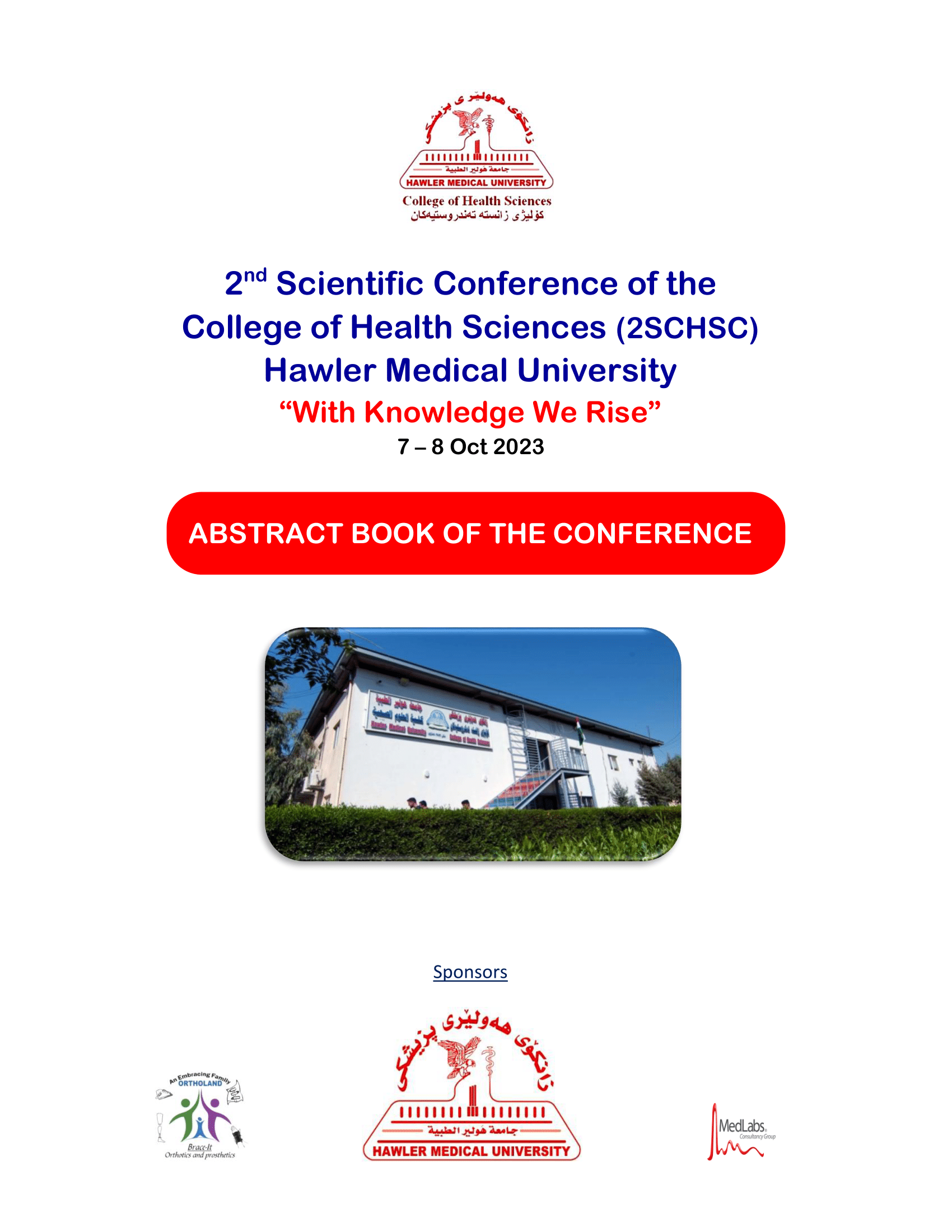Frequency distribution patterns of some human traits in the Kurdistan region's population: A survey
DOI:
https://doi.org/10.15218/hcchs.2023.08Keywords:
Genetic Traits, Inheritance Pattern, Phenotype Frequency, Genes, AllelesAbstract
Background and objective: The study of genetic attributes across multiple nations has revealed the complex interaction of heredity that forms our species. Specifically, the Kurdistan region, with its distinctive demographic history, offers anpossibility to investigate patterns of common human traits. This study aimed to analyze the genetic framework that influences specific traits in this population, giving insights with significant medical implications.
Methods: Data on nine phenotypic traits controlled by a single gene were collected from 602 participants from the Kurdistan region. Ethical standards were maintained by obtaining informed consent from all participants, ensuring privacy, and adhering to ethical research practices. The statistical analysis was conducted using Jamovi 2.3.21, employing Chi-square tests to assess differences in trait distribution across genders.
Results: The survey evaluated the distribution of traits such as widow's peak, straight hairline, earlobes, facial Dimples, tongue folding, tongue rolling, cleft chin, hitchhiker's thumb, bent little finger, and hand clasping. Significant differences in the prevalence of these traits were found between genders. For instance, widow's peak was observed in 26% of the population, showing a higher frequency in males compared to females. Other traits like tongue rolling and cleft chin also exhibited significant gender differences, which indicates that dominant alleles were predominant than recessive alleles.
Conclusion: This study highlights the genetic diversity and specific inheritance patterns of traits within the Kurdistan region’s population. While some traits displayed a recessive pattern, the overall genetic influence was significant. Future studies should expand on this genetic analysis and incorporate larger sample sizes to enhance the knowledge of genetic diversity and its implications in medical and genetic research.
References
MedlinePlus [Internet]. Bethesda (MD): National Library of Medicine (US). Why are some genetic conditions more common in particular ethnic groups? [updated 2021 Apr 19; reviewed 2023 Jun 01; cited 2024 Jul 2]. Available from: https://medlineplus.gov/genetics/understanding/inheritance/.
Genovesi, E., Blinderman, L., & Natale, P. (n.d.). Human Traits Determined by Single Genes. In Unfolding the Mystery of Life: Biology Lab Manual for Non-Science Majors. [Accessed2023]. Available from: https://bio.libretexts.org/Unfolding_the_Mystery_of_Life_-_Biology_Lab_Manual_for_Non-Science_Majors.
Zschocke J. Dominant versus recessive: Molecular mechanisms in metabolic disease.Journal of Inherited Metabolic Disease2008;31(5):599-618. doi:10.1007/s10545-008-1016-5. DOI:10.1007/s10545-008-1016-5.
Heim WG. What is a recessive allele? The American Biology Teacher. 1991;53(2):94-97.DOI:10.2307/4449229.
Medland SE, Nyholt DR, Painter JN, et al. Common variants in the trichohyalin gene are associated with straight hair in Europeans. The American Journal of Human Genetics. 2009;85(5):750-755.DOI:10.1016/j.ajhg.2009.10.009.
Thibaut S, Gaillard O, Bouhanna P, Cannell DW, Bernard BA. Human hair shape is programmed from the bulb. British Journal of Dermatology. 2005;152(4):632-638.DOI:10.1111/j.1365-2133.2005.06521.x.
El Kollali R. Earlobe morphology: a simple classification of normal earlobes. Journal of plastic, reconstructive & aesthetic surgery. 2009;62(2):277-280.DOI: 10.1016/j.bjps.2008.01.046
Wiedemann H. Cheek dimples. Am J Med Genet. 1990;36(3):376-376. DOI:10.1002/ajmg.1320360337.
Reedy JJ, Szczes T, Downs TD. Tongue rolling among twins. Journal of Heredity. 1971;62(2):125-127.DOI:10.1093/oxfordjournals.jhered.a108139. 10. Nwaopara AO, Anibeze CIP, Apkuaka FC, Agbontaen OF. Morphogenetic traits combination pattern amongst the population of Ekpoma, Nigeria: Focus on tongue rolling, ear lobe attachment, blood groups and genotypes. African Journal of Biotechnology. 2008;7(20).
Odokuma EI, Eghworo O, Avwioro G, Agbedia U. Tongue rolling and tongue folding traits in an African population. International Journal of Morphology2008;26(3):533-535.DOI:10.4067/S0717-95022008000300004. 12. Armand L, Jerome WY, Albert T. Saito, TA. Genetic study on the abnormal Camptodactyly. Journal of the American Medical shortenings of the finger Japanese Journal of Human Association. 1968;206:1565-1567.
Glass B, Kistler JC. Distal hyperextensibility of the thumbs. Human Heredity. 1953;4(2-3):192-206.DOI:10.1159/000150741.
Lebow MR, Sawin PB. Inheritance of human facial features: a pedigree study involving length of face, prominent ears and chin cleft. Journal of Heredity. 1941;32(4):127-132.DOI:1 0.1093/oxfordjournals.jhered.a105016.
Rassman WR, Pak JP, Kim J. Phenotype of normal hairline maturation. Facial Plastic Surgery Clinics. 2013;21(3):317-324.DOI:10.1016/j.fsc.2013.04.001.
Ceballos C, Priego C, Méndez C, Hoffner MV, García-Hernández MJ, Camacho FM. Study of frontal hairline patterns in Spanish Caucasian women. Actas Dermo-Sifiliográficas (English Edition). 2013;104(4):311-315.DOI:10.1016/j.adengl.2012.10.009.
Nusbaum BP, Fuentefria S. Naturally occurring female hairline patterns. Dermatologic Surgery. 2009;35(6):907-913.DOI:10.1111/j.1524-4725.2009.01154.x.
Alija AJ, Bajraktari ID, Bresgen N, et al. Frequency Distribution and Association of some Morpho-and Physiological Traits in Patients with Lung Diseases in Kosova. Collegium antropologicum. 2015;39(4):907-913.
Abimbola EO. A study on tongue rolling, tongue folding and cerumen type in a Nigeria population. Anatomy Journal of Africa. 2019;8(2):1540-1543.DOI:10.4314/aja.v8i2.188220. 20. Razzaq, Rabia, et al. "Tongue rolling, folding, cheek dimple and chin cleft; study of a morphogenetic traits in Quetta population." World J Zool 10.3 (2015): 237-40.
Gao W, Li L, Cao W, et al. Physical features observation: is it repeatable in zygosity determination of Chinese adult twins? Twin Research and Human Genetics. 2010;13(1):96-100.DOI:10.1375/twin.13.1.96.
Reiss M. The genetics of hand-clasping a review and a familial study. Annals of Human Biology. 1999;26(1):39-48. DOI:10.1080/030144699282967.
Downloads
Published
How to Cite
Issue
Section
License
Copyright (c) 2025 Radwan Rushdi Mohammed, Barzan Muhamad Anwar, Abdulghani Taib Abdullah

This work is licensed under a Creative Commons Attribution-NoDerivatives 4.0 International License.











